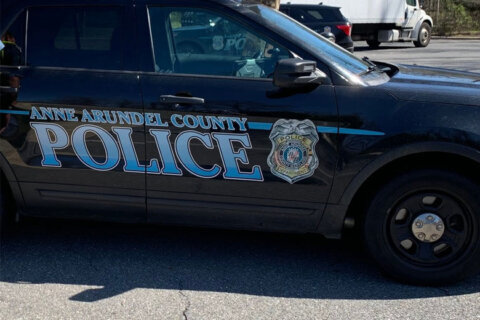This article was republished with permission from WTOP’s news partners at Maryland Matters. Sign up for Maryland Matters’ free email subscription today.
This content was republished with permission from WTOP’s news partners at Maryland Matters. Sign up for Maryland Matters’ free email subscription today.
Carr’s Beach in Annapolis is an almost mythological name in Maryland history – one of a few Black-owned beaches along the Severn River that became a regular stop for top-flight performers on the “Chitlin Circuit” during the Jim Crow era, as well as a place of recreation for families shut out of the region’s segregated beaches.
Today, there isn’t much evidence that the place ever existed, except for a small spit of sand and a few historical signs along a wood-chip path off a side road near a bustling boatyard.
But within a year or so, that will change. With substantial financial help from the federal, state and Anne Arundel County governments, as well as a few nonprofits, the City of Annapolis recently purchased a six-acre plot of land that includes the beach, and local officials plan to build a waterfront park there that will pay tribute to the area’s history.
“This land will now be a place for everybody,” Annapolis Mayor Gavin Buckley (D) said Thursday.
Buckley was one of several state and local officials and community leaders who gathered at the spot to tout the collaborative effort to buy and preserve the property and hail it as a shining example of a new state initiative to preserve and protect parkland.
The Great Maryland Outdoors Act, which passed during the most recent General Assembly session, was introduced in response to the great demands placed on state parks during the worst of the COVID-19 pandemic, when Marylanders flocked to outdoor recreation spaces that often became overrun by crowds. The measure provides an additional $162 million for the maintenance and acquisition of parkland and to hire more workers at state parks.
“It’s the largest historical investment in state parks in our history,” said state Senate President Bill Ferguson (D-Baltimore City).
The bill’s sponsors – House Majority Leader Eric Luedtke (D-Montgomery) and Sen. Sarah Elfreth (D-Anne Arundel), who represents Annapolis – were on hand, along with former Gov. Parris N. Glendening (D), who, with Elfreth and Luedtke, headed a commission that produced the legislation. Glendening, who lives just a few coves south of Carr’s Beach, said it’s rare to see such a substantive piece of legislation move through the General Assembly so quickly and with near-unanimous support.
All the speakers said the new initiative would improve and expand parkland, preserve Maryland history, prevent sprawl, and help fight climate change at a time when the use of state parks has doubled in less than a decade.
“We haven’t always been good stewards of our parks,” said Luedtke, who called this new era of government investment the third wave, following the Civilian Conservation Corps of the 1930’s and the post-World War II era. “It’s been 50 years since we’ve invested on this scale.”
Some of the acquisitions won’t be cheap.
Vincent Leggett, founder and president of the nonprofit group Blacks of the Chesapeake, said in an interview that Annapolis bought the Carr’s Beach property for about $6.5 million. It had been passed down from the Carr family, the original owners, to “Little Willie” Adams, a prominent Black business leader and political heavyweight in Baltimore, to Theo Rodgers, another Baltimore businessman and an Adams protégé. Rodgers has been under pressure for years to sell the property to real estate developers.
Leggett said that “within 12 to 18 months this place will be transformed with trails and kiosks and history.” He added that the goal of local political and civic leaders is to acquire more land along the peninsula – “a string of pearls that tell a more complete story about African-American leisure, recreation and history, and more about African-American business.”
Buckley, ticking off the names of famous artists who had performed at Carr’s Beach, like James Brown and Stevie Wonder, said the city would not have been able to acquire the property without financial help – and the new state legislation.
“Welcome to a place where the coolest people on the planet used to play music and have fun and really put Annapolis on the map as a cultural place,” he said. “…What they did is now a profound part of Annapolis history.”
But there won’t just be investments in maintenance and construction projects in the future. There will also be investments in human capital: The state legislation provides about $12 million for the state to hire more park rangers, maintenance workers and administrative staff.
“The thing I’m proudest of is standing for our park rangers and government employees,” Elfreth said.
Dean Hughes, superintendent of four state parks in Central Maryland and the president of the Maryland Rangers Association, said in an interview that the legislation provides “a blueprint for success.” The state currently has about 230 park rangers working, and the measure will enable the state to hire at least another 90 rangers and other park workers beginning in July 2023.
Hughes said he and his colleagues hope the program proves to be a success and that it leads to even more state investments in parks.
“What’s good for the parks is good for the rangers and what’s good for the rangers is good for the parks,” he said.







